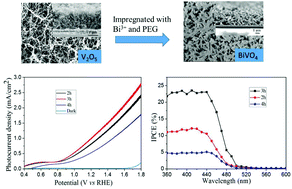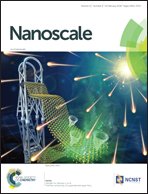Preparation of a BiVO4 nanoporous photoanode based on peroxovanadate reduction and conversion for efficient photoelectrochemical performance†
Abstract
A unique, controllable and facile method based on peroxovanadate reduction and conversion to prepare BiVO4 nanoporous films is presented. In this method, a slow and controllable reduction of peroxovanadate with ethanol was used, which was the crucial step to ensure the uniform deposition of V2O5·xH2O on an F-doped tin oxide substrate, and subsequently the annealed V2O5·xH2O film was converted to a BiVO4 film by a simple impregnation method with Bi3+ under the oriented effect of polyethylene glycol. The converted BiVO4 film possessed a single monoclinic scheelite structure and exhibited an optimal water splitting photocurrent density of 1.10 mA cm−2 at 1.23 V vs. RHE in 0.1 M KH2PO4 (pH 7) under AM 1.5G illumination with an incident photon-to-current conversion efficiency of ∼22.4% at 400 nm using an annealed V2O5·xH2O film deposited for 3 hours. The BiVO4 film also showed excellent water splitting performance and degradation efficiency in the PEC degradation of methylene blue and tetracycline hydrochloride with a rate constant of 0.63 h−1 and 0.21 h−1, respectively.



 Please wait while we load your content...
Please wait while we load your content...